Whether you are a 20-something who has never created something with her hands or a retiree looking for a new social hobby, needlework is guaranteed to fit the ticket. But where do you start? If you are new to the world of needlework, you might be wondering “is it easier to learn to knit or crochet?”
The bottom line is that whether it’s knitting or crocheting, the easiest needlework craft is the one that you practice the most. Neither one is truly easier than the other, so you might even try your hand at both. At the same time, you’ll never be able to master either craft if you give up before you really get started. The two crafts have many differences that may make one easier than the other depending on your crafting goals. Keep reading to learn more about the unique aspects of knitting vs. crocheting.
What are the differences between knitting and crocheting?
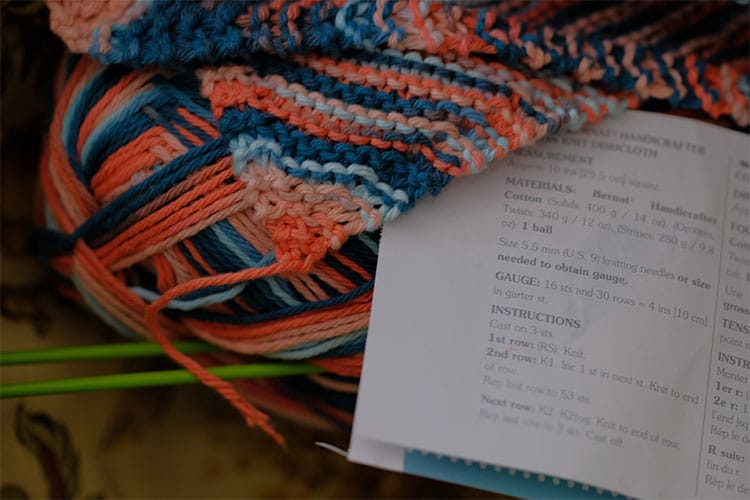
If you are an absolute beginner, there are a few things differences between knitting and crocheting that you should know before you get started. In terms of similarities, both crochet and knitting use tools (hooks or needles) to manipulate yarn and make fabric. You can use either needlework style to make projects ranging from baby clothes to full-size blankets.
Knitting requires the use of two long needles. As you knit, you loop your stitches from one needle to the other until you “cast off” and finish your project. The individual stitches look like loops, which gives the fabric a nice stretch. The result is a light fabric that has few holes. Knitted fabrics are great for light blankets and clothing that fits close to the body.
On the other hand, crochet only uses one hook to twist yarn into knot-like stitches. Compared to knitting, crochet only manipulates one stitch at a time. The finished crochet fabric is typically stiffer and bulkier than knit. This makes it ideal for housewares, thick blankets, and hats.
There are plenty of people who are competent knitters and crocheters, so there’s no reason why you shouldn’t try both. If you still need help deciding which one to start first, read on for a comprehensive list of the pros and cons of knitting and crocheting.
What Are the Pros of Knitting?
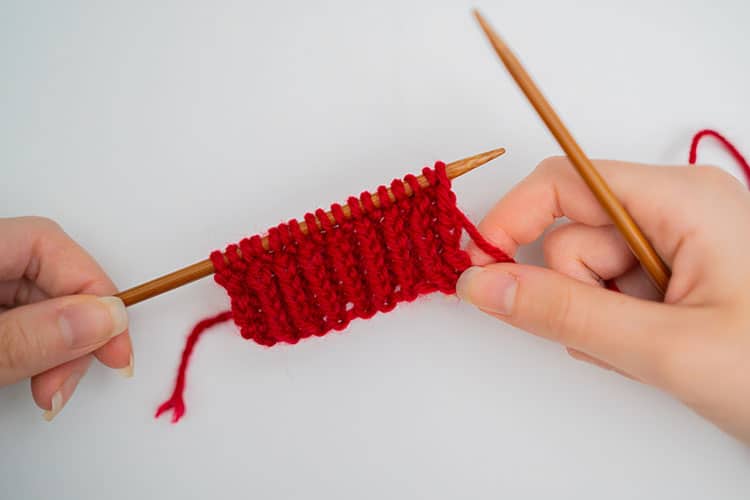
1. Community
Learning how to knit can be easier because there is a great community of people who you can teach you how to get started. Knitting has always been more popular than crochet, which means that it’s more than likely you know someone who can sit down and walk you through the 4 basic stitches. Another great option is to find a class at your local craft store. Knitting classes are a great way to have a professional give you tips on the type of yard to use and how to improve your technique.
2. Patterns
For some reason, the crafting community decided on knitting as it’s needlework project of choice. This means that there are literally hundreds of thousands of patterns that you can find online, in magazines, and in craft stores. As a new knitter, this is great because you will have so many different projects that you can choose from as you get started. The shear volume of variety might be a great motivator to keep you knitting long enough to get good at it.
3. Availability of supplies
The popularity of knitting means that there are always lots of options for knitting supplies. At the average craft store, up to 70% of the needlework isle will be devoted to knitting. There are always tons of knitting needles in various sizes, styles, and materials. Yarn will be labeled with the best needle size to use. This makes it really easy for a new knitter to get started and develop their craft.
4. Simple stitches
In knitting, there are only four main techniques (cast on, knit, purl, cast off). The purl stitch is even technically optional! Because of this, it is very easy to get started with knitting. If a steep learning curve isn’t for you, then try giving knitting a try.
5. Make stitches the same size
Since all of your knitted stitches will stay on the needle, it can be much easier to get the stitches the same size. If you need to adjust the tension slightly to make sure that your loops stay in perfectly straight lines, this is also easier because your loops are guided by the straightness of your hooks.
6. Versatility
Since knitting produces a light, thin, opaque fabric, it’s a popular choice for clothing, baby clothes, and light blankets. Many clothing items, like scarves, only use a few different stitches, which makes it easy to knit a fashionable clothing item that you can wear right away.
7. Professional looking garments
If you are looking to make clothing that you would feel confident wearing out and about, knitting might just be for you. Knitting makes a thin fabric that doesn’t have a lot of holes, so it’s ideal for sweaters, socks, or any type of clothing that will fit close to the body. If you are interested in making these types of garments, it will be much easier to make them by knitting.
8. Knitting machines
Even if you throw knitting out the window altogether, you can still make knitted material thanks to the existence of knitting machines. If you look at mass-produced clothing, much of it will be knitted because knitting machines can create the same material as hand-made. After you get the hang of knitting, a knitting machine could help you produce more items more quickly.
What are the Pros of Crocheting?
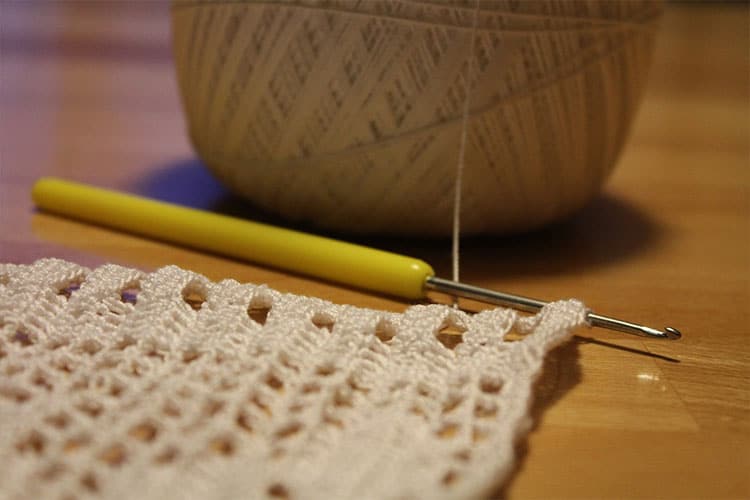
1. Easy to advance after you get started
While crocheting might have a bit of a learning curve, it is very easy to advance after you get started. There are many different stitches in crochet, but they are all combinations and modifications of the basic crochet stitches. Once you have the general know-how for crochet, you can quickly move on to more complex and detailed projects.
2. Finish your projects quicker
A crocheted fabric typically looks like it’s made of little knots. The fabric tends to be lacier with lots of space in between stitches. All this space means that you can finish your projects more quickly. You can easily finish your first scarf in a couple of evening crochet sessions, and once you get the hang of it, you can complete whole blankets in a matter of days!
3. Patterns are easy to read
Crochet patterns are generally pretty repetitive, which makes them easy to read. This is great if you are a beginner and want to learn to crochet different types of projects. Instead of having to Google each symbol, you may be familiar with most of the stitches it takes to complete a project.
4. Lots of room for creativity
When you crochet, you basically put your hook through various different loops to make shapes and designs. Because of this, it is much easier to crochet in a free and flowy style. Crochet makes it easy to develop your unique style and use your creativity.
5. Versatile
Crochet on its own can make lovely blankets, hats, and scarves. But don’t stop there! The stiff material is great for making structured outerwear, housewares, and more. And don’t forget that you can use crochet to make fun amigurumi creatures.
6. Easy to fix mistakes
One of the best parts about crochet for beginners is that it’s easy to go back and fix your mistakes. Since only one stitch is “live” at a time, all you have to do is pull your thread to back up a few stitches to where you messed up. Dropped stitches and missed stitches are also much easier to fix with crochet.
7. Portable
It’s hard to build a habit when you can’t get in a consistent routine. Luckily, you’ll be able to take your crochet projects with you anywhere. Crochet hooks can be much smaller than knitting needles, so they can be easy to throw into a purse. Also, since crochet hooks aren’t pointed, you’ll never have any problems taking them on an airplane. (You can probably still take knitting needles on an airplane, but it might be a little more iffy than with crochet hooks.)
8. Easier for single-handedness
Since crochet only uses one hook, some people find it easier if they prefer to use one hand. The other hand will still be used, but not quite as equally as with knitting. This can make it easier for left-handed crafters because it will be easier for them to just use their left hand. Crochet may also be easier if you are just especially clumsy with one hand.
9. Ergonomic handles on crochet needles
If you are a crafter with arthritis or carpal tunnel syndrome, crochet might be for you. Crochet hooks come in a variety of styles, and many of them have ergonomically designed handles to help relieve strain on the wrist. This is helpful if you are working on projects that are harder on the wrist, such as larger blankets or crochet lace made out of thread.
What are the Cons of Knitting?
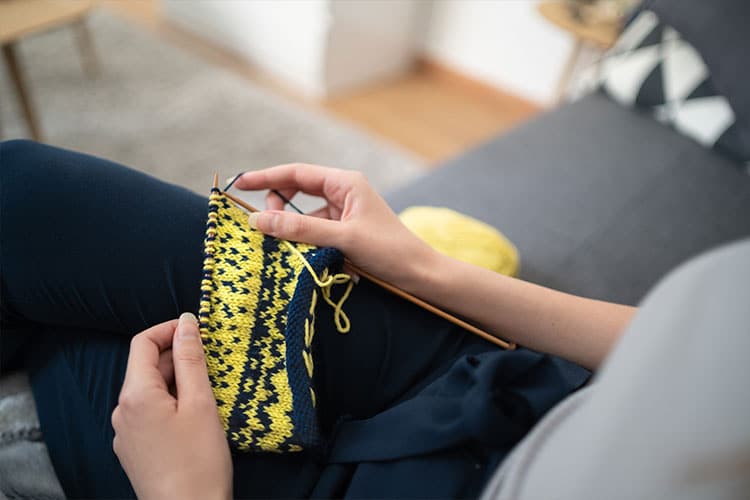
1. Difficult to fix mistakes
The most difficult thing about knitting is that it can be nearly impossible to correct your mistakes. A dropped stitch can result in a hole in your fabric and messing up a stitch can ruin every stitch after it. You can try to unknit, but this is often tricky business that can actually result in a bigger mess than when you started.
2. Difficult to make accessories
Making accessories, like crochet flowers or little amigurumi dolls are very hard to recreate in knit. Knit flowers usually require many steps and sewing to stitch all the pieces together. They may be more trouble than what they’re worth.
3. Not a lot of room for creativity
Knitting is a very logical craft. You make lots of straight rows and you can clearly see how all of your stitches lead to the next one. However, this doesn’t leave a lot of room for creativity or to go off the beaten path. Freeform knitting hasn’t caught on as much as it has for crochet.
4. Turning the fabric
In knitting, you will inevitably have to turn your fabric, especially if you are knitting in the round. While this isn’t a problem when you get used to it, it can sometimes be difficult for a beginner to turn their fabric without losing track of their stitches or where to start next.
5. Hard on your hands
An unfortunate reality of any craft is that it can be very difficult on the hands. All the small, repetitive, fine-motor movements can induce carpal tunnel syndrome if you aren’t careful about using proper technique and tension. While some crochet hooks are designed with ergonomic handles, knitting needles are completely straight. This might make them uncomfortable to hold over time, especially if you are prone to carpal tunnel and arthritis.
6. Takes a long time
Knitted fabric has a flat, smooth texture due to its small stitches. However, because the stitches are so small, it can take a long time to complete a project. If you are the kind of person who is easily discouraged when you don’t see quick progress, it may be harder for you to get started with knitting.
What Are the Cons of Crocheting?

1. Getting the hang of crochet can be more difficult
One common complaint about crochet is that it can be difficult to get started. Some people find that the movements of crocheting are awkward to get the hang of. They might give up before they are able to complete their first project. Other beginners will have problems holding their projects too tightly. It’s common to be tense when you start a new project, but the added tension can make your stitches too small and make the fabric difficult to work with.
2. Difficult to find patterns
An unfortunate reality of crochet is that it has never been as popular as knitting. As a result, it can be difficult to find new, creative, and modern patterns. It can be difficult for a beginner to get started if they aren’t able to find an attractive pattern that they are willing to spend the time on. Beginners may have better luck looking online rather than in crochet books.
3. Uses more yarn
Crochet can be faster to make, but the speed comes at the cost of yarn. While it’s universally accepted that crochet uses more yarn, exactly how much depends on who you ask. Claims generally range from 5%-33% more yarn. So, while it may not be a huge difference, the cost can really add up if you are using high-quality yarns like cashmere. While it doesn’t make crocheting harder, the extra yarn expense is something that a new crafter may need to take into consideration.
4. Bulky fabric
One of the benefits of crochet is that it produces a warm, thick fabric. On the other hand, this means that the fabric tends to be too bulky for certain clothing items. If you want to make clothes that fit close to the body, like socks and sweaters, it can be difficult to create a wearable piece with crochet.
5. Lack of stretch
Another problem in crocheting clothing is that the fabric doesn’t have very good stretch. The fabric has more memory (goes back to its original shape easier) but it can be difficult to create garments that are movement-friendly.
6. Lots of stitches to learn
While knitting only has two basic stitches, there are lots of different stitches in crochet. This adds to the amount of creativity you can use when crocheting, but it can be difficult for a beginner to learn a stitch that you may only use for a single project.
7. No crochet machines available
This is rarely considered a con for most crafters, but it may be if you were eventually planning on increasing the number of products you could produce for your Etsy store. At the moment, no machine can reproduce the look of handmade crochet (though such a machine would undoubtedly be a lucrative invention.)
Both knitting and crochet are a great way to relax while creating hand-made items. It just starts with a little practice. So, go out to the nearest craft store, pick out some pretty yarn, and start creating!
Related:
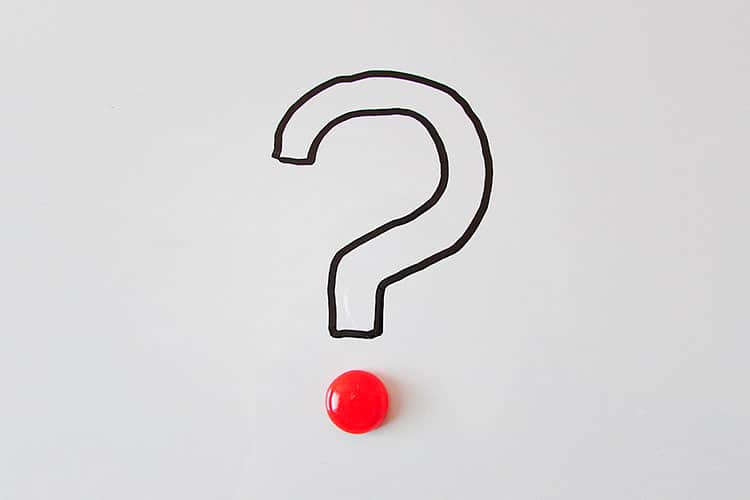
Is knitting or crocheting easier for left-handed crafters?
If you are a southpaw, you are at a slight disadvantage with both crochet and knitting. Some left-handed crafters find crochet more intuitive because it only requires the use of your dominant hand. Also, since there are fewer patterns, you may be encouraged to make more of your own patterns, which you can modify to make the most sense for you.
At the same time, other crafters will say that knitting is easier to learn because it already requires the use of both hands. You can either learn how to knit the standard way, or you can flip your knitting patterns to make them left-handed.
Either way, knitting and crocheting may require some mental gymnastics to mentally flip your patterns or to mirror the actions your teacher is demonstrating. If you are learning from a right-handed crafter, it may be easiest to sit across as you try to mirror their movements. The best solution would be to find a fellow left-handed crafter who already knows how to knit and crochet so you can learn from them.

